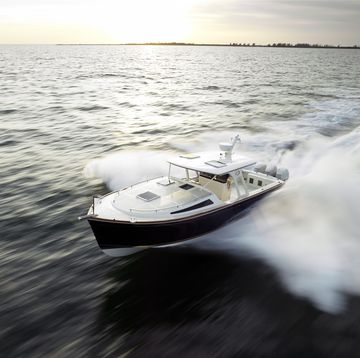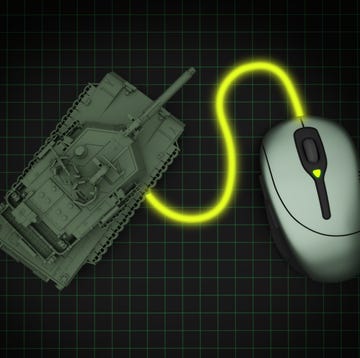Shock Test
To measure the locks' resilience against brute force—the kind they'd feel from a sledgehammer—we used an MTS Systems shock test machine to drop a 32-pound weight on them.
Franklin: One drop from 55 inches (the machine's max height) popped the lock.
Medeco: Three drops and the lock was reduced to a cloud of plastic and steel shrapnel.
Master: The toughest lock slowly pulled apart over the course of four drops from max height.
OnGuard: Just one drop smashed the lock's plastic shell and unlatched the shackle.
Winner: Master
Bolt-Cutter Test
Bolt cutters can be a burglar's best friend. We used a platform scale to measure how much force bolt-cutter handles needed to snap the shackles.
Franklin: Applying just 95 pounds of pressure to the bolt cutter's handles snapped the weakest shackle.
Medeco: It took 110 pounds of force to snip the shackle.
Master: The second-toughest shackle broke after 200 pounds of squeeze.
OnGuard: The toughest lock was the only one to survive this test—after 270 pounds of pressure, the bolt-cutter teeth began to bend, but the shackle was left with just a small groove.
Winner: OnGuard
Tensile Test
How much force does it take to pull the shackle out of the cylinder? We used an Instron tensile testing machine to find out.
Franklin: The shackle on the weakest lock was pulled free with just 1024 pounds.
Medeco: The runner-up met its end with 6436 pounds of force.
Master: It took a whopping 7745 pounds of force to pull the winner loose.
OnGuard: 3072 pounds of pull and the lock was sprung.
Winner: Master
Salt-Fog Test
To simulate sitting outside a shed through years of acid rain and environmental exposure, we left the locks in a chamber for an intense weeklong onslaught of sulfur-dioxide salt fog.
Franklin: A week of sulfur dioxide left the Franklin permanently stuck shut.
Medeco: We had high hopes for Medeco's "All-Weather" lock. And although it survived the sulfur dioxide, curiously, it wouldn't open after seven days with a weaker, nonsulfuric salt fog.
Master: The Master left the test looking like it had been submerged on the Titanic for a century, but it still opened.
OnGuard: This lock finished looking like we'd plucked it from a swamp but still working.
Winner: Tie between Master and OnGuard
Gunshot Test
In Hollywood heists, burglars frequently shoot open locks. To see how these padlocks handle bullets, we shot the cylinders with a rifle from 80 feet away.
Franklin: Although centered shots passed right through the lock, it took an off-center bullet from a .243 Winchester to actually spring it.
Medeco: A single centered shot from a .25-06 Remington left this lock unlatched—and with a large exit hole.
Master: Behold, the bulletproof lock—the Master stopped .243 Winchester and Remington .25-06 shots in their tracks. Not even a pair of bullets from a .300 Winchester Magnum could pass through or open this lock.
OnGuard: After one off-center shot from the .25-06 Remington, we were able to pull the lock open by hand. As with the Franklin, centered shots passed through the cylinder but failed to actually open it.














